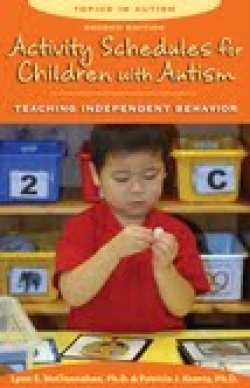Activity Schedules for Children with Autism
Autistic children are often developmentally delayed with little interest in either familial or peer-to-peer relationships. They can also be prone to angry and even violent behavior when routines are interrupted and change is introduced. Anyone who has spent time with an autistic child understands that helping him or her to learn and develop into a productive member of the family and community is a daunting challenge. In [i]Activity Schedules for Children with Autism[i], Lynn McClannahan, PhD, and Patricia Krantz, PhD, present the activity schedule, “a set of pictures or words that cues someone to engage in a sequence of activities,” as a promising teaching method for autistic children.
Activity schedules can vary widely in appearance, though they are often a page or pages held in a photo album or a three-ring binder. Each page contains a picture or description of a specific activity on a plain background. When possible, pictures should be arranged to show how the item in the picture is used. For example, “you might photograph a five-piece puzzle with four pieces, and the fifth beside the puzzle.” Whether play or chores, activities should reflect the skills and interests of the child. The last item in a schedule should be a snack or an activity that the child particularly enjoys.
Children must have certain basic skills in order to use activity schedules, and the book begins with an explanation of how to help a child gain those skills. Once this is accomplished, the teacher or parent can start to create schedules and engage the autistic child in using them. Techniques for teaching a child to use schedules include manual guidance (physically guiding a child through an activity), appropriate rewards, changing locations of prompts, and avoiding verbal instruction. The book also discusses when and how to change activities in a schedule, guiding parents and teachers through the steps necessary to help a child as he or she advances. This second edition covers storing schedules on PDAs, ipods, and other similar devices—tools which can assist an autistic individual who needs to carry a schedule throughout the day. Individual stories provide powerful examples of how people of all ages use activity schedules to structure their lives, from young children engaged in household chores to adults in the workplace.
This is a must-have resource for anyone working with an autistic person, either child or adult. The authors, both of whom are widely recognized for their expertise in autism interventions, state, “activity schedules provide a framework that helps parents and teachers plan and include many different science-based procedures that help youngsters develop new skills.” This book effectively demonstrates that, though the task is not an easy one, with the techniques and concepts presented here, autistic children can learn to be happy and productive.
Reviewed by
Catherine Thureson
Disclosure: This article is not an endorsement, but a review. The publisher of this book provided free copies of the book and paid a small fee to have their book reviewed by a professional reviewer. Foreword Reviews and Clarion Reviews make no guarantee that the publisher will receive a positive review. Foreword Magazine, Inc. is disclosing this in accordance with the Federal Trade Commission’s 16 CFR, Part 255.

